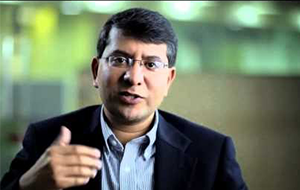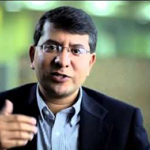There is $8 trillion worth of data being stored by today's companies. That's a lot of business value, yet most companies are not making the best use of this enormous asset. How can your business move from data overload to getting full business value from its data? In this interview, Suhale Kapoor, executive vice president and co-founder of big data analytics firm Absolutdata supplies some answers.

The Enterprisers Project (TEP): How can an enterprise find and make use of its data so as to realize the greatest business value?
 Kapoor: An abundance of data is driving today's business environment, which is coming at an ever increasing rate from multiple sources online and offline. Organizations are leveraging this massive amount of data to grab new opportunities, power business growth, ensure cost effectiveness, and decipher changing trends. The increasing adoption of advanced age analytic techniques such as big data technologies and machine learning have made it imperative for enterprises to maximize business value from data.
Kapoor: An abundance of data is driving today's business environment, which is coming at an ever increasing rate from multiple sources online and offline. Organizations are leveraging this massive amount of data to grab new opportunities, power business growth, ensure cost effectiveness, and decipher changing trends. The increasing adoption of advanced age analytic techniques such as big data technologies and machine learning have made it imperative for enterprises to maximize business value from data.
To draw the most value from data, begin by eliminating bad data. Lack of focus on managing the quality of data can adversely impact the organization. According to a survey, the cost of data quality rework can cost more than two percent of the organization's annual value.
Next, companies need to confront the management of an almost unimaginable volume of unstructured data. If they do, they will be in a position to respond quickly to market changes, utilize the latest information on trends and customer demand to develop entirely new services, and secure their competitiveness in the long run.
For the future, it's just as important to identify and tap newer data sources that are cropping up as this helps the enterprises to stay abreast with the most modern trends and also know the current and potential customer sentiments about your products. It's also essential to make the right investments. Organizations need to invest in the people, processes, and technology around data management to improve this valuable asset and leverage it for organizational performance.
TEP: What are some of the coming trends in data analysis?
Kapoor: Organizations are gradually opening up to the big data world. Major mining companies are using big data for predictive maintenance and anticipating component failures; telecom giants are predicting customer purchase patterns through predictive analytics; big automobile companies have been using data collected during customer interactions for decision making. Small businesses are not far behind. They have started leveraging a combination of in-house and third-party technologies for developing a 360-degree view of their customers by using data coming from multiple sources.
The Internet of Things is another emerging trend. Shortly IoT will revolutionize the methods by which organizations target, engage and interact with consumers in their everyday operations. With the massive amount of data generated from an influx of connected devices, IoT will allow organizations to harmonize an ever-increasing quantum of data and help them right from the stage of product planning to marketing and execution of products.
Machine learning is another emerging trend. With new computing technologies, machine learning today is not like machine learning of the past. While many algorithms have been around for a long time, the ability to automatically apply complex mathematical calculations to big data over and over faster and faster is a recent development. Machine learning automates analytical model building to classify an event or predict an outcome. The models are self-learning, and improve themselves by observing the newer data.
Another new trend is geospatial analytics. Location-based marketing is a great opportunity for consumer products brands to connect with their customers wherever their products are sold, either working with their distribution channel and retailers or independently from them. Location-based marketing enables organizations to communicate special offers or discounts to consumers who are nearby. Retailers are immensely benefiting from this as they can talk about specific product launches, demos, or free samples and associate their brands with a place, time and even a context such as weather.
TEP: What are some common mistakes companies make around data?
Kapoor: Every organization today recognizes that the exponential increase in the volume, velocity, and variety of data represents a great opportunity. What they don't always fully grasp is how data can be leveraged to draw the right kind of insight that will enable them to develop analytics into a competitive advantage.
Not having the right resources is one common challenge. Most organizations do not have the ability to develop deep, data-driven insights. They are unable to identify and prioritize what types of insights would be most relevant to the business. Successful analytics teams can build those capabilities by blending data, technical and business talent together. Organizations need a disciplined team of decision scientists and engineers, who can accelerate value extraction from the systems. A strong team comprising statistical, machine learning experts, and visualization specialists is needed to create data-driven decision-making solutions.
Failing to capture the right data is another common problem. Organizations need a strategic plan for collecting data (social media, sensor data, transaction data, and mobile phone usage data) and aligning it with the business strategy to create value from data. A sound data policy is a must to map all the relevant data sources and build a data view on the business. And quality data must be collected and stored in a manner that is easy to access.
Another common mistake is failing to deploy the right tools. Advanced analytics and big data tools are a prerequisite for setting up a big data practice. Commonly used database management tools cannot process such massive data sets within a tolerable elapsed time.
TEP: What advice would you give CIOs on how to draw value from big data?
Kapoor: Big data is a priority and should be at the top of a CIO's checklist. Given the dynamic nature of market trends and opportunities at presents, it will continue to be important for some time to come. Before rushing to create impact using big data technologies, it is important for CIOs to stop and take stock of some of the fundamentals. Are the risks being effectively managed? Are the opportunities being fully seized?
The biggest puzzle many CIOs currently face is how to get value from all the unstructured data their companies hold. The vast amounts of diverse, unstructured data that companies are rapidly accumulating, both from external sources (e.g., Twitter posts) and internal sources (e.g., customer emails) is leaving many of them overwhelmed. But some organizations are managing to draw valuable insights from this flood of data.
Balancing your approach between analytical and intuitive, being open to new ideas about gaining value from data and building cross-functional teams to gain insights from different perspectives will all help you make the best use of data.
CIOs should look for a data scientist who possesses strong mathematical and analytical skills and also are proficient at handling massive data sets. And they should seek data engineers, who are capable of crunching numbers, understand the math behind building the models and can find insights. They should also have sound knowledge of the businesses domain and an understanding of its customers and processes. That will help them communicate data findings effectively.




